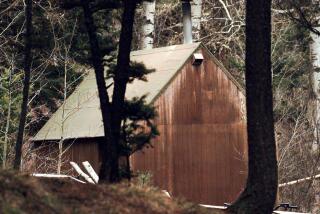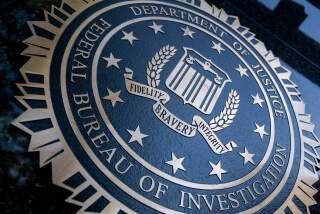Defense Asks Judge to Bar Evidence in Unabomber Case
- Share via
SACRAMENTO — Attorneys for accused Unabomber Theodore J. Kaczynski on Monday urged a federal judge to toss out evidence seized nearly a year ago at Kaczynski’s Montana cabin, saying the FBI was “deliberately misleading” in obtaining a search warrant.
In several hundred pages of documents filed late Monday, defense lawyers Quin Denvir and Judy Clarke maintained that the FBI “simply failed to provide any trustworthy information that would convince a reasonably prudent person that Mr. Kaczynski committed the Unabomb crimes.”
To buttress their argument, the defense lawyers provided a detailed critique of the 104-page search warrant affidavit that sought to establish links between Kaczynski and the Unabomber.
In particular, they contend that the government misrepresented DNA evidence, failed to disclose information that Kaczynski did not match the description of the Unabomber “in virtually any respect,” and covered up evidence showing that Kaczynski had an alibi for a 1985 fatal bombing in Sacramento.
As a result, the defense lawyers are asking U.S. Judge Garland E. Burrell Jr. to exclude all evidence seized in April at Kaczynski’s remote cabin.
That evidence includes a stack of documents that prosecutors have described as the backbone of the case against the former UC Berkeley mathematics professor, including entries in which they say he took responsibility for the deadly, coast-to-coast trail of 16 bombings.
An FBI spokesman declined to comment on the defense legal brief.
After Kaczynski’s arrest, the government released a list of evidence removed by FBI agents from his cabin, including bomb components, notebooks and typewriters that allegedly tied him to the bombings that started in 1978 and killed three and injured 23.
In June, a federal grand jury indicted Kaczynski in four Unabomber-related explosions, including two fatal attacks--the 1985 death of Sacramento computer store owner Hugh Scrutton and the 1995 death of Capitol timber industry lobbyist Gilbert Murray. Kaczynski, 54, remains in Sacramento County Jail awaiting trial.
Seeking to poke holes in the government’s case, Kaczynski’s lawyers said that documents available to the FBI provided their client with an alibi for the 1985 Sacramento bombing.
“Specifically, bank records and information from bank officials all showed Mr. Kaczynski personally making a deposit in Helena, Mont., on the date of a Unabomb event in Sacramento,” according to defense documents.
Another major point made by the defense was that the government’s search warrant affidavit failed to reveal that DNA testing excluded Kaczynski as the source of DNA on two Unabomb letters and probably excluded him as the source of DNA on a third letter.
A third issue in dispute involves the description of the Unabomb suspect given in 1987 by an eyewitness who saw a man plant an explosive device in the rear parking lot of a Salt Lake City computer store.
In contrast to the witness’ description, Kaczynski was 14 to 19 years older, 1 to 3 inches shorter and had a more muscular build, according to the defense team.
Authorities had been searching for the Unabomber since 1978, when his first attack came at Northwestern University, north of Chicago. The FBI gave the case the code name “Unabomb” because early targets included universities and airlines.
More to Read
Sign up for Essential California
The most important California stories and recommendations in your inbox every morning.
You may occasionally receive promotional content from the Los Angeles Times.













